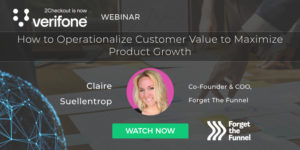In this post, we distill insights from our recent webinar featuring Claire Suellentrop, a seasoned marketing expert and co-founder of Forget the Funnel.
With over 13 years of industry experience, Claire shares strategies to help businesses discover their ideal customers and quantify customer value, with the aim of maximizing product growth.
So, if you’re a merchant interested in staying ahead of the competition through innovative customer-centric approaches, this wrap-up is a must-read.
Can Customer Value Be Measured?
All businesses want to make decisions that will help deliver more customer value, however, most are unaware of how to quantify and measure it. Is it even possible to discuss customer value as a tangible metric?
Clare argues that measuring customer value can be, in fact, achieved. During the session, she provides a clear step-by-step roadmap to unveiling and gauging it, so that businesses can leverage this knowledge to develop better product growth and go-to-market strategies.
Her process is fairly straightforward, consisting of 3 steps:
- Isolate: Identify your ideal customers.
- Learn: Uncover why they searched for a solution and picked your product.
- Reverse Engineer: Quantify what matters to your customers, then action it.

Source: Forget The Funnel
While we only cover some of the highlights of the roadmap in this post, consider exploring the full webinar How to Operationalize Customer Value to Maximize Product Growth for a more comprehensive understanding.
Step One: Isolate
Claire emphasizes the importance of identifying your ideal customers early on. As she explains it, your focus should start with a circle of a broader group of people who have made a clear statement about the value of your product by paying for it.
You might wonder whether to include customers on freemium plans or in trial periods in this group, but the spotlight should only be on those who are actively paying customers.
Claire narrows this circle by focusing on those customers who in addition to paying, are actively engaged with your product.
The goal here is to shift the attention to those who find consistent value in your offering, as opposed to customers who have made a one-time purchase or who, for instance, subscribed with their credit card a few months ago and have since forgotten about it.
From here, Claire suggests isolating the circle even further. Within that group of paying customers who regularly use your product, focus on the segment that has become paying just recently.
The rationale behind this is simple: this specific group of people still remember their pain points and the reasons why they chose your product prior to their conversion.
These people will have the clearest memory of what it was like to search for a solution that led them to you. Ideally, you would be looking at your paying customers who have converted within the past year.
Step Two: Learn
Once you have narrowed down your group of customers, your next step is to uncover the unique struggles that have pushed them towards searching for a solution like yours. Identifying their motivations and desired outcomes will help you understand their perceived value in your product.

Source: Forget The Funnel
To help us visualize this process better, Claire presents a case study of three distinct customer segments she encountered while working with three companies.
These brands offer vastly different products that cater to diverse markets and solve unique problems:
1. An Invoicing Tool: To help customers invoice on the go.
This first company learned that their best customers were mobile workers—individuals providing services like home cleaning, landscaping, or contracting. These customers struggled to invoice on the go, leading the company to prioritize a mobile solution that works on smartphones and tablets.
2. A Remote Hire Company: To help businesses make a remote hire fast and easy.
Claire highlights that this global hiring platform had customers facing the challenge of hiring candidates located in different countries. The primary concern was overcoming the logistical hurdles of hiring talent internationally, emphasizing the need for a solution that simplified this process.
3. A Compliance App: To help customers prove compliance.
The third company, offering an Automatic Screenshot Capture Tool, catered to businesses in highly regulated industries such as healthcare and finance. Their customers needed a reliable system to capture and archive screenshots for compliance purposes, providing evidence of their website’s appearance over time.

Source: Forget The Funnel
The different struggles of each customer base in these scenarios lead to distinct desires and motivations. The invoicing tool’s customers wanted flexibility in their operational tool and needed a mobile solution.
There are many complex invoicing tools on the market, but this group of customers valued simplicity through the ability of invoicing on the go.
Similarly, the global hiring platform’s customers needed a hassle-free and quick resolution to hiring employees worldwide, without having to worry about managing these HR processes in-house.
And finally, the Compliance app’s customers prioritized the reliability and the convenience of having archived screenshots at their fingertips.
Step Three: Reverse Engineer
This final step is where, as Claire puts it, “the rubber meets the road”.
Reverse engineering is all about translating the previously gained knowledge into actionable product growth.
To help us understand how to do this better, Claire uses a framework where customer experience is mapped in three fundamental phases:

Source: Forget The Funnel
Struggle
Your customer’s journey starts as they’re struggling to find a solution to their problem. At this point, they haven’t heard about your product yet.
Claire explains that contrary to what most user journey maps will tell you, your customer experience doesn’t begin when they sign up for your product but rather starts when they first feel the pain of having to abandon their current solution to find a new one.
At that moment, the struggle will lead them to seek out new products that will address their pain points, and that’s the ideal time for you to reach out with relevant marketing.
Evaluation
Once the customer discovers your brand’s existence, they invest time into researching your product to make an informed buying decision.
The evaluation phase represents the milestones in their buying journey, where they explore your website, product offering, and maybe get a demo – in an attempt to understand whether your product fits their needs.
Growth
The last growth phase represents your customer embedding your product into their daily or monthly workflow and habits.
Ideally, you’d want them to engage with your product, invite other users, and perhaps even demonstrate loyalty by upgrading to the next tier.
Measuring Values & KPIs
Now’s the fun part.
The three phases described above each categorize different columns: blue, green, yellow, orange, red and pink, as shown in the image above. Each of these columns represents an individual milestone that your customer has to go through to arrive at the final step of their experience.
The top blocks of the columns are labeled as values. This is where you have to fill in the unique values that your customer needs to experience at each stage. The bottom blocks represent the KPIs associated with the values.
Moving on, Claire divides the key values in this framework into 3 categories: first value, value realization, and continued value (see image below).

Source: Forget The Funnel
First value occurs during your customer’s initial engagement with your product.
Value realization then follows when they enter their payment details to purchase your offering.
Continued value happens when your customers are consistently deriving benefits from your products. They establish a routine and become loyal.
In your Reverse Engineering step, rather than defining values from left to right of this framework, you will start by first identifying the “moment of certainty” or value realization as Claire puts it. This is when your customer has chosen your product, is willing to invest in it, and is not exploring other solutions.
By understanding this pivotal state when customers are ready to commit to your product, you can further reverse engineer this process. That would involve determining the necessary steps your customer must take to reach this moment of value.
Your last step is identifying your customer’s desired outcome for your product. This is the ultimate state that they envision for themselves, where your product has solved their problems and continues to provide value regularly.
In the case of the invoicing tool, the desired outcome is achieving better record keeping. For the global hiring platform, it’s retaining international talent, and with the screenshot capture app, it’s the peace of mind associated with compliance.
Understanding these values will enable you to establish connections and identify the actions your customer would take to achieve their desired outcome.
As Claire explains, this is exactly where learning what your customers have valued in their qualitative experience starts to become quantifiable. Once you have identified these values, you can define and measure the KPIs associated with them.
From there, leveraging this data will enable you to take proactive actions to ensure your product meets and exceeds customer expectations, which will in turn help establish effective go-to-market strategies and maximize your product growth.
Wrapping Up
Unlocking the true value of your product lies in understanding your customer journey. Measuring customer values is no longer a theoretical exercise, but rather a crucial strategy for businesses that aim to stay ahead of the competition through a customer-centric approach.
By aligning your KPIs with customer values, you can track and optimize key milestones in your customer journey, ensuring a data-driven methodology that leads to sustained growth and improved customer experience.
Dive into the full webinar How To Operationalize Value To Maximize Product Growth to harness these transformative strategies for your business success.






